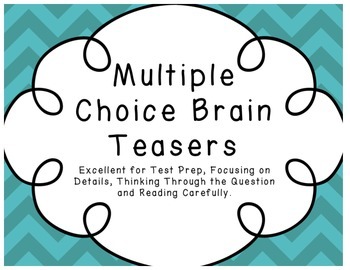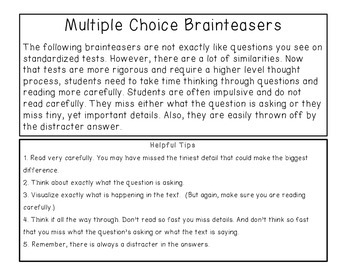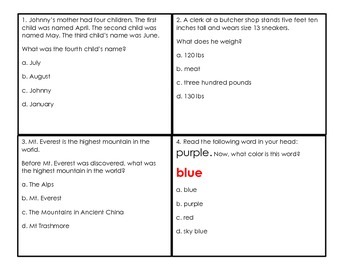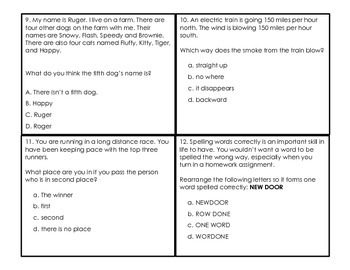Multiple Choice Brain Teasers
verbivore
96 Followers
Grade Levels
3rd - 6th
Resource Type
Standards
CCSSRL.3.1
CCSSRL.4.1
CCSSRL.5.1
CCSSRF.3.4c
CCSSRF.4.4c
Formats Included
- PDF
Pages
14 pages, 44 task cards
verbivore
96 Followers
Description
The following brainteasers are not exactly like questions you see on standardized tests. However, there are a lot of similarities. Now that tests are more rigorous and require a higher level thought process, students need to take time thinking through questions and reading more carefully. Students are often impulsive and do not read carefully. They miss either what the question is asking or they miss tiny, yet important details. Also, they are easily thrown off by the distracter answer.
These cards can also be used as brain challenges. Brain research shows us that doing things that are challenging grows new neurons and actually grows your brain. These cards will give students a challenge and force them to stick to a task and really think it through.
The majority of these brain teasers are actually pretty simple to figure out. However, our brains get tricked because we think we know the simple answer and usually it's because we missed a very tiny detail that changes everything. So pay attention!
This set consists of 44 task cards. They can be used for small group or independent activities.
These cards can also be used as brain challenges. Brain research shows us that doing things that are challenging grows new neurons and actually grows your brain. These cards will give students a challenge and force them to stick to a task and really think it through.
The majority of these brain teasers are actually pretty simple to figure out. However, our brains get tricked because we think we know the simple answer and usually it's because we missed a very tiny detail that changes everything. So pay attention!
This set consists of 44 task cards. They can be used for small group or independent activities.
Total Pages
14 pages, 44 task cards
Answer Key
N/A
Teaching Duration
N/A
Report this resource to TPT
Reported resources will be reviewed by our team. Report this resource to let us know if this resource violates TPT’s content guidelines.
Standards
to see state-specific standards (only available in the US).
CCSSRL.3.1
Ask and answer questions to demonstrate understanding of a text, referring explicitly to the text as the basis for the answers.
CCSSRL.4.1
Refer to details and examples in a text when explaining what the text says explicitly and when drawing inferences from the text.
CCSSRL.5.1
Quote accurately from a text when explaining what the text says explicitly and when drawing inferences from the text.
CCSSRF.3.4c
Use context to confirm or self-correct word recognition and understanding, rereading as necessary.
CCSSRF.4.4c
Use context to confirm or self-correct word recognition and understanding, rereading as necessary.





